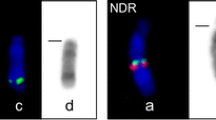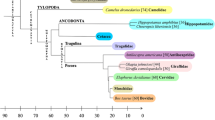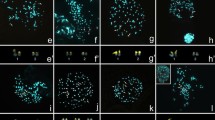Abstract
Five families are traditionally recognized within higher ruminants (Pecora): Bovidae, Moschidae, Cervidae, Giraffidae and Antilocapridae. The phylogenetic relationships of Antilocapridae and Giraffidae within Pecora are, however, uncertain. While numerous fusions (mostly Robertsonian) have accumulated in the giraffe’s karyotype (Giraffa camelopardalis, Giraffidae, 2n = 30), that of the pronghorn (Antilocapra americana, Antilocapridae, 2n = 58) is very similar to the hypothesised pecoran ancestral state (2n = 58). We examined the chromosomal rearrangements of two species, the giraffe and pronghorn, using a combination of fluorescence in situ hybridization painting probes and BAC clones derived from cattle (Bos taurus, Bovidae). Our data place Moschus (Moschidae) closer to Bovidae than Cervidae. Although the alternative (i.e., Moschidae + Cervidae as sister groups) could not be discounted in recent sequence-based analyses, cytogenetics bolsters conclusions that the former is more likely. Additionally, DNA sequences were isolated from the centromeric regions of both species and compared. Analysis of cenDNA show that unlike the pronghorn, the centromeres of the giraffe are probably organized in a more complex fashion comprising different repetitive sequences specific to single chromosomal pairs or groups of chromosomes. The distribution of nucleolar organiser region (NOR) sites, often an effective phylogenetic marker, were also examined in the two species. In the giraffe, the position of NORs seems to be autapomorphic since similar localizations have not been found in other species within Pecora.










Similar content being viewed by others
Abbreviations
- AAM:
-
Antilocapra americana
- BAC:
-
Bacterial artificial chromosome
- BAK:
-
Bovidae ancestral karyotype
- BTA:
-
Bos taurus
- cenDNA:
-
Centromeric DNA
- CDR:
-
Camelus dromedarius
- CHI:
-
Capra hircus
- CR:
-
Centromeric region
- DOP-PCR:
-
Degenerate oligonucleotide primed polymerase chain reaction
- EDA:
-
Elaphurus davidianus
- FISH:
-
Fluorescence in situ hybridization
- GCA:
-
Giraffa camelopardalis
- HSA:
-
Homo sapiens
- LINE:
-
Long interspersed nucleotide elements
- MMO:
-
Moschus moschiferus
- NOR:
-
Nucleolar organiser region
- OJO:
-
Okapia johnstoni
- PAK:
-
Pecoran ancestral karyotype
- pter:
-
Terminus of p arm
- qter:
-
Terminus of q arm
- SINE:
-
Short interspersed nucleotide elements
References
Bonnet A, Thévenon S, Claro F, Gautier M, Hayes H (2001) Cytogenetic comparison between Vietnamese sika deer and cattle: R-banded karyotypes and FISH mapping. Chromosom Res 9:673–687
Bonnet-Garnier A, Claro F, Thévenon S, Gautier M, Hayes H (2003) Identification by R-banding and FISH of chromosome arms involved in Robertsonian translocations in several deer species. Chromosom Res 11:649–663
Brown JD, O’Neill RJ (2010) Chromosomes, conflict, and epigenetics: chromosomal speciation revisited. Annu Rev Genom Hum Genet 11:291–316
Buckland RA, Evans HJ (1978) Cytogenetic aspects of phylogeny in the Bovidae. Cytogenet Cell Genet 21:64–71
Cabelova K, Kubickova S, Cernohorska H, Rubes J (2012) Male-specific repeats in wild Bovidae. J Appl Genet 53:423–433
Cernohorska H, Kubickova S, Vahala J, Robinson TJ, Rubes J (2011) Cytotypes of Kirk’s dik-dik (Madoqua kirkii, Bovidae) show multiple tandem fusions. Cytogenet Genome Res 132:255–263
Cernohorska H, Kubickova S, Vahala J, Rubes J (2012) Molecular insights into X;BTA5 chromosome rearrangements in the tribe Antilopini (Bovidae). Cytogenet Genome Res 136:188–198
Chaves R, Guedes-Pinto H, Heslop-Harrison JS, Schwarzacher T (2000) The species and chromosomal distribution of the centromeric α-satellite I sequence from sheep in the tribe Caprini and other Bovidae. Cytogenet Cell Genet 91:62–66
Chaves R, Adega F, Heslop-Harrison JS, Guedes-Pinto H, Wienberg J (2003) Complex satellite DNA reshuffling in the polymorphic t(1;29) Robertsonian translocation and evolutionarily derived chromosomes in cattle. Cromosom Res 11:641–648
Chaves R, Santos S, Guedes-Pinto H (2004) Comparative analysis (Hippotragini versus Caprini, Bovidae) of X-chromosome’s constitutive heterochromatin by in situ restriction endonuclease digestion: X-chromosome constitutive heterochromatin evolution. Genetica 121:315–325
Chaves R, Guedes-Pinto H, Heslop-Harrison JS (2005) Phylogenetic relationships and the primitive X chromosome inferred from chromosomal and satellite DNA analysis in Bovidae. Proc Biol Sci 272:2009–2016
Chi J, Fu B, Nie W, Wang J, Graphodatsky A, Yang F (2005) New insights into the karyotypic ralationships of Chinese muntjac (Muntiacus reevesi), forest musk deer (Moschus berezovskii) and gayal (Bos frontalis). Cytogenet Genome Res 108:310–316
Decker JE, Pires JC, Conant GC et al (2009) Resolving the evolution of extant and extinct ruminants with high-throughput phylogenomics. Proc Natl Acad Sci U S A 106:18644–18649
Di Meo G, Perucatti A, Chaves R et al (2006) Cattle rob(1;29) originating from complex chromosome rearrangements as revealed by both banding and FISH-mapping techniques. Chromosom Res 14:649–655
Ferguson-Smith MA, Trifonov V (2007) Mammalian karyotype evolution. Nat Rev Genet 8:950–962
Gallagher DS Jr, Derr JN, Womack JE (1994) Chromosome conservation among the advanced Pecorans and determination of the primitive bovid karyotype. J Hered 85:204–210
Gallagher DS Jr, Davis SK, De Donato M et al (1999) A molecular cytogenetic analysis of the tribe Bovini (Artiodactyla: Bovidae: Bovinae) with an emphasis on sex chromosome morphology and NOR distribution. Chromosom Res 7:481–492
Goldammer T, Brunner RM, Rebl A et al (2009a) Cytogenetic anchoring of radiation hybrid and virtual maps of sheep chromosome X and comparison of X chromosomes in sheep, cattle, and human. Chromosom Res 17:497–506
Goldammer T, Brunner RM, Rebl A (2009b) A high-resolution radiation hybrid map of sheep chromosome X and comparison with human and cattle. Cytogenet Genome Res 125:40–45
Goodpasture C, Bloom SE (1975) Visualization of nucleolar organizer in mammalian chromosomes using silver staining. Chromosoma 53:37–50
Hassanin A, Douzery EJP (2003) Molecular and morphological phylogenies of Ruminantia and the alternative position of the Moschidae. Syst Biol 52:206–228
Hassanin A, Delsuc F, Ropiquet A et al (2012) Pattern and timing of diversification of Cetartiodactyla (Mammalia, Laurasiatheria), as revealed by a comprehensive analysis of mitochondrial genomes. C R Biol 335:32–50
Huang L, Chi J, Nie W, Wang J, Yang F (2006) Phylogenomics of several deer species revealed by comparative chromosome painting with Chinese muntjac paints. Genetica 127:25–33
Huang L, Nesterenko A, Nie W et al (2008) Karyotypic evolution of giraffes (Giraffa camelopardalis) revealed by cross-species chromosome painting with Chinese muntjac (Muntiacus reevesi) and human (Homo sapiens) paints. Cytogenet Genome Res 122:132–138
Iannuzzi L, Di Berardino D, Gustavsson I, Ferrara L, Di Meo GP (1987) Centromeric loss in translocations of centric fusion type in cattle and water buffalo. Hereditas 106:73–81
Iannuzzi L, Di Meo GP, Perucatti A, Incarnato D, Schibler L et al (2000) Comparative FISH-mapping of bovid X chromosomes reveals homologies and divergences between the subfamilies Bovinae and Caprinae. Cytogenet Cell Genet 89:171–176
Iannuzzi L, King WA, Di Berardino D (2009) Chromosome evolution in domestic Bovids as revealed by chromosome banding and FISH-mapping techniques. Cytogenet Genom Res 126:49–62
ISCNDB 2000 (2001) International system for chromosome nomenclature of domestic bovids. Cytogenet Cell Genet 92:283–299
Jobse C, Buntjer JB, Haagsma N, Breukelman HJ, Beintema JJ, Lenstra JA (1995) Evolution and recombination of bovine DNA repeats. J Mol Evol 41:277–283
Kubickova S, Cernohorska H, Musilova P, Rubes J (2002) The use of laser microdissection for the preparation of chromosome-specific painting probes in farm animals. Chromosom Res 10:571–577
Kulemzina AI, Trifonov VA, Perelman PL et al (2009) Cross-species chromosome painting in Cetartiodactyla: reconstructing the karyotype evolution in key phylogenetic lineages. Chromosom Res 17:419–436
Marcot JD (2007) Molecular phylogeny of terrestrial artiodactyls: Conflicts and resolution. In: Prothero DR, Foss SE (eds) The evolution of artiodactyls (pp 367). The John Hopkins University Press, Baltimore (MD), pp 4–18
Miyamoto MM, Goodman M (1986) Biomolecular systematics of eutherian mammals. Phylogenetic patterns and classification. Syst Zool 35:230–240
Nguyen TT, Aniskin VM, Gerbault-Seureau M et al (2008) Phylogenetic position of the saola (Pseudoryx nghetinhensis) inferred from cytogenetic analysis of eleven species of Bovidae. Cytogenet Genome Res 122:41–54
Pauciullo A, Kubickova S, Cernohorska H (2006) Isolation and physical localization of new chromosome-specific centromeric repeats in farm animals. Vet Med Czech 51:224–231
Perucatti A, Genualdo V, Iannuzzi A et al (2012) Advanced comparative cytogenetic analysis of X chromosomes in river buffalo, cattle, sheep, and human. Chromosom Res 20:413–425
Petit P, de Meurichy W (1986) On the chromosomes of the okapi. Okapia johnstoni. Ann Genet 29:232–234
Piumi F, Schibler L, Vaiman D, Oustry A, Cribiu EP (1998) Comparative cytogenetic mapping reveals chromosome rearrangements between the X chromosomes of two closely related mammalian species (cattle and goats). Cytogenet Cell Genet 81:36–41
Rens W, O'Brien PCM, Yang F et al (2001) Karyotype relationships between distantly related marsupials from South America and Australia. Chromosom Res 9:301–308
Robinson TJ, Ropiquet A (2011) Examination of Hemiplasy, homoplasy and phylogenetic discordance in chromosomal evolution of the Bovidae. Syst Biol 60:439–450
Robinson TJ, Ruiz-Herrera A (2008) Defining the ancestral eutherian karyotype: a cladistic interpretation of chromosome painting and genome sequence assembly data. Chromosom Res 16:1133–1141
Robinson TJ, Wilson V, Gallagher DS Jr et al (1996) Chromosomal evolution in duiker antelope (Cephalophinae: Bovidae): Karyotype comparisons, fluorescence in situ hybridization, and rampant X chromosome variation. Cytogenet Cell Genet 73:116–122
Robinson TJ, Harrison WR, Ponce de León FA, Davis SK, Elder FF (1998) A molecular cytogenetic analysis of X chromosome repatterning in the Bovidae: transpositions, inversions, and phylogenetic inference. Cytogenet Cell Genet 80:179–184
Rocchi M, Archidiacono N, Schempp W, Capozzi O, Stanyon R (2012) Centromere repositioning in mammals. Heredity 108:59–67
Ropiquet A, Gerbault-Seureau M, Deuve JL et al (2008) Chromosome evolution in the subtribe Bovina (Mammalia, Bovidae): the karyotype of the Cambodian Banteng (Bos javanicus birmanicus) suggests that Robertsonian translocations are related to interspecific hybridization. Chromosom Res 16:1107–1118
Ropiquet A, Hassanin A, Pagacova E et al (2010) A paradox revealed: karyotype evolution in the four horned antelope occurs by tandem fusion (Mammalia, Bovidae, Tetracerus quadricornis). Chromosom Res 18:277–286
Rubes J, Kubickova S, Musilova P et al (2005) Assignment of chromosome rearrangements between X chromosomes of human and cattle by laser microdissection and Zoo-FISH. Chromosom Res 13:569–574
Rubes J, Kubickova S, Pagacova E et al (2008) Phylogenomic study of spiral-horned antelope by cross-species chromosome painting. Chromosom Res 16:935–947
Rubes J, Musilova P, Kopecna O, Kubickova S, Cernohorska H, Kulemsina AI (2012) Comparative molecular cytogenetics in Cetartiodactyla. Cytogenet Genome Res 137:194–207
Saffery R, Earle E, Irvine DV, Kalitsis P, Choo KH (1999) Conservation of centromere protein in vertebrates. Chromosom Res 7:261–265
Seabright M (1971) A rapid banding technique for human chromosomes. Lancet 2:971–972
Slate J, Van Stijn TC, Anderson RM et al (2002) A deer (subfamily Cervinae) genetic linkage map and the evolution of ruminant genomes. Genetics 160:1587–1597
Ugarković D, Plohl M (2002) Variation in satellite DNA profiles—causes and effects. EMBO J 21:5955–5959
Wilson DE, Reeder DM (2005) Mammal species of the world. Johns Hopkins University Press, Baltimore
Acknowledgements
This work was supported by grants GA CR P506/10/0421, MZE 0002716202 and by the project “CEITEC”- Central European Institute of Technology (ED1.1.00/02.0068) from European regional Development Funds (HC, SK, OK, JR). Research grants of the Russian Fund for Basic Research, programs of the Russian Academy of Science MCB and Integration program of the SB RAS (AIK, PLP, ASG) and the South African National Research Foundation (TJR) are acknowledged. We thank Mitch Bush, David Wildt (Brookfield Zoo, IL, USA) and S. O’Brien for Okapia johnstoni material and A. A. Sharshov for Moschus moschiferus which was collected in the Altai region, Russia.
Author information
Authors and Affiliations
Corresponding author
Additional information
Responsible Editor: Walther Traut
Electronic supplementary material
Below is the link to the electronic supplementary material.
ESM Table S1
(DOC 31 kb)
Rights and permissions
About this article
Cite this article
Cernohorska, H., Kubickova, S., Kopecna, O. et al. Molecular cytogenetic insights to the phylogenetic affinities of the giraffe (Giraffa camelopardalis) and pronghorn (Antilocapra americana). Chromosome Res 21, 447–460 (2013). https://doi.org/10.1007/s10577-013-9361-0
Received:
Revised:
Accepted:
Published:
Issue Date:
DOI: https://doi.org/10.1007/s10577-013-9361-0




